Blackjack is a game of skill and, as such, it allows players to predict, to some extent, the outcomes of their choices and moves. In order to win in the long term, they need to acquire the necessary knowledge and skills and strive to improve their game each time they play.
However, it should be noted that, regardless of all the strategies and useful tips players may know, gambling is still gambling and there is no guarantee of the outcome of a particular hand.
No strategy guarantees that they will inevitably achieve the desired result, but the right approach significantly increases their chances of winning, and this is what makes blackjack so interesting and exciting.
Important Things to Consider About Blackjack Odds
One of the first things new players should look for when deciding which game to play is the game’s odds and probabilities. Many people choose to try their luck at blackjack because, in most casinos, the odds of winning are in the players’ favour.
However, one must take into account that the game’s outcome can be predicted only if they apply the basic strategy correctly and have the necessary skills and discipline. Otherwise, the game becomes just like any other casino game in which skills and knowledge make no difference.
History of the Odds
The prominent mathematicians Julian Braun and John Scarne were among the first people to observe and study the odds and probabilities of the game. They discovered how particular moves could steer the game in a completely new direction and that its odds could be determined to some extent because it follows a repeated pattern.
Their discoveries and strategies are famous all over the world and have contributed greatly to the blackjack games we know today. Other gaming experts and mathematicians who have advanced players’ understanding of the game include Edward O. Thorp, Harvey Dubner, Peter Griffin, Donald Schlesinger and Stanford Wong, among others.
The Basic Concepts of Odds and Probability
Before we delve any deeper, we would like to provide readers with brief explanations of what odds and probabilities are. Probability is a separate branch of mathematics that studies how likely or unlikely events are to occur. Blackjack players can use probability to determine the likelihood of winning or losing with certain hands against specific upcards of the dealer.
Probability is calculated by dividing the number of winning outcomes by the number of all possible outcomes. The probability is presented either as a percentage or as a decimal number.
Let’s assume a person wants to figure out the probability of drawing any given card out of a freshly reshuffled deck. With the jokers removed, the deck contains 52 cards, each of which has the same probability of being drawn as the rest.
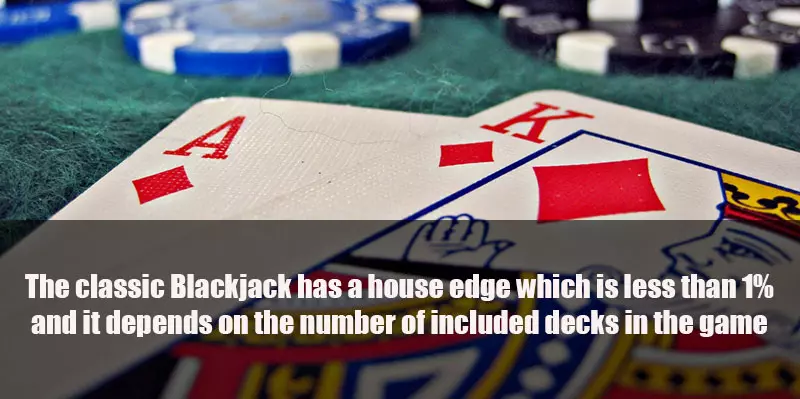
Thus, the probability of drawing any given card, let us say the Queen of spades, is 1 in 52, or 1 / 52 = 0.0192, which is 1.92%. The likelihood of drawing any Queen from a fresh full deck is 4 in 52 (4 / 52 = 0.0769, or 7.69%). There are four Queens in a single 52-card deck, one for each of the four suits (spades, diamonds, clubs, hearts), hence the higher probability of pulling out one of them.
Odds are related to probability, but the two are not the same thing, as some players may think. The term “odds for” denotes the ratio of winning to losing outcomes, whereas “odds against” is the opposite, i.e. it shows the ratio of losing to winning results.
Therefore, the odds of drawing any of the four Queens from one full deck are 4 to 48 (4:48), while the odds against pulling out a Queen are 48 to 4 (48:4) because there are 48 other cards and only four Queens. The odds format is handy since it furthers the comparison between true odds and casino odds (the payouts on winning bets).
A fair game pays out at true odds, i.e. the mathematical probability of winning coincides with the winning wagers’ payouts. Casino games, blackjack included, do not pay at true odds due to the built-in house edge that generates long-term profits for the casino.
Calculating Probabilities in Blackjack
Before we proceed with the actual calculations, let’s first demonstrate how blackjack odds fluctuate as the composition of the deck or shoe changes. It would be easier to do this with an example where we have a jar containing ten red and ten blue hard candies, all diligently mixed together.
The probabilities of pulling out a red or a blue candy at random coincide (10/20, or 50%) since we start with an equal number for each colour. You reach into the jar without looking and pull out one red candy. This causes the probability of grabbing a red candy the next time you reach in to drop to 9/19, or a little over 47%.
Meanwhile, the likelihood of taking out a blue candy increases with each red one that leaves the jar. Assuming you place bets on the colour of these sweets, you would stand better chances of winning if you wagered on blue on the third try.
With two red candies already removed, the blue ones become the better bet since their probability increases to 10/18, or 55.55%. If you are pressing for bigger wins, you will bet more on blue in this case, would you not?
Notice that the probabilities change only if you do not return the candies to the jar after each result. Had you been doing this, the likelihood of taking out either colour would have been the same each time, or 10/20.
This sugary game we just made up is the same as blackjack, where outcomes are also dependent and interact with each other. What has happened in the past influences what will happen in the future. Here are a few more examples to see how this applies to the game of 21.
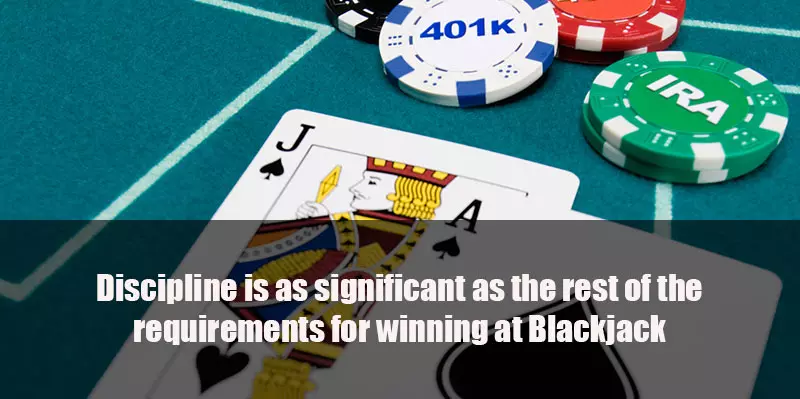
Probabilities of Different-Length Losing Streaks in Blackjack
Blackjack is a game that is based on luck and skill. Casino experts know that winning or losing streaks are not an uncommon phenomenon at the blackjack tables, and not only there. Nobody can tell for how long the streak will continue. However, blackjack devotees can calculate the probability of losing consecutive rounds. Usually, a losing streak that lasts for more than four rounds is rare, but it is still a possibility.
To calculate the probability of a losing streak, you have to use the negative probability value and vice versa. On the Internet, you can find various loss-streak probability calculators, but we would like to provide you with information about the probabilities of different-length winning and losing streaks in blackjack. The probability of a win in a typical shoe blackjack game is 43.3%, a push is 8.7%, and a loss is 48.0% if you use the basic strategy.
When we talk about losing or winning streaks, we have to ignore the pushes. This means that the probability of winning is 47.4% and the probability of losing amounts to 52.6%. Hence, the chance of losing two hands in a row equals 0.526² = 0.2766. To express this number as a percentage, you have to multiply it by 100, or 0.2766 × 100 = 27.66%. Meanwhile, the probability of winning two hands in a row is 0.474² = 0.2246, which is 0.2246 × 100 = 22.46%. In that way, you can easily calculate the probabilities of different-length winning and losing streaks in blackjack. For the convenience of our readers, we have prepared a table that illustrates the probability of winning and losing up to six hands in a row.
| Length of the Streak | Probability of Winning | Probability of Losing |
|---|---|---|
| 2 | 22.46% | 27.66% |
| 3 | 10.65% | 14.55% |
| 4 | 5.05% | 7.65% |
| 5 | 2.39% | 4.02% |
| 6 | 1.13% | 2.12% |
As you can see from the table, the chance of continuous winning or losing streaks diminishes the more wins or losses you hit in a row.
The Three Laws of Probability
Probability is governed by three rules, or laws, to be precise: those of multiplication, addition, and complementation. Under the law of complementation, the likelihood of something not happening equals 1 minus the likelihood of the same thing happening.
There are 13 cards of each suit in a single deck. Therefore, the likelihood of you pulling out any card of the clubs suit is equal to 13 / 52 = 0.25, or 25%. Respectively, the probability against pulling clubs is 1 – 0.25 = 0.75, or 75%.
The law of addition states that the likelihood of one out of two, three, four, etc. outcomes occurring is the sum of the events’ individual probabilities minus the likelihood of all of them happening. Therefore, the likelihood of getting a deuce or a card of the clubs suit is equal to [(4 / 52) + (13 / 52)] – 1 / 52 = 17 / 52 – 1 / 52 = 16 / 52 = 0.3077, or 30.77%.
Finally, there is the law of multiplication. For games of dependent trials like blackjack, it dictates that the likelihood of all possible events from a fixed set of outcomes is the product of their conditional probabilities. This is the more complex way of saying the likelihood of an outcome occurring is influenced by the outcomes that occurred before it.
To show you how this works, let’s check out the probability of drawing three ten-value cards from a single 52-card deck without replacing the discards as is the case in blackjack. There are 16 ten-value cards, so the probability of pulling one of them out is 16 / 52. The likelihood of drawing another ten next decreases to 15 / 51 since now we have 15 tens out of a total of 51 cards.
The same applies to getting a third ten in a row as now we have 14 tens out of 50 cards. The likelihood drops to 14 / 50. It follows that the probability of getting three tens out of a freshly opened pack is (16 / 52) × (15 / 51) × (14 / 50) = 0.0253, or 2.53%. If all 16 tens leave the deck, this percentage will drop to zero.
How Card Removal Influences Blackjack Odds and Probabilities
Unlike casino games based on sole chance, blackjack revolves around dependent trials. Instead of remaining static like in games of chance, the odds in blackjack change each time a card is removed from play. The precise value of the discard also influences the odds and the players’ expectation.
Having a flexible value, the ace is the single most important card in the entire game. On one hand, it helps you obtain blackjacks and receive a bonus payout of one-and-a-half times your wager. On the other, aces give you soft hands you cannot bust with on the next hit. It therefore makes sense that the removal of aces has the most dramatic effect on your expected value.
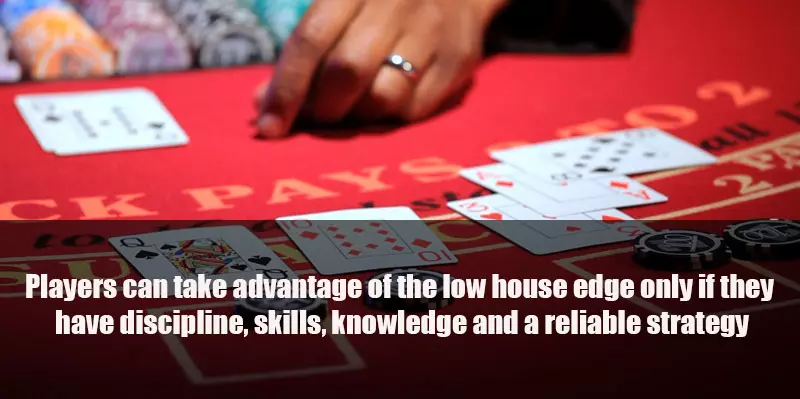
The probability of hitting blackjacks drops with each ace that leaves the deck. If all four aces are dealt out of a fresh full deck, players’ chances of receiving the coveted 3 to 2 payout would be nil. But what about cards of other denominations? Is their removal as important as that of the aces?
Gaming specialists have tackled this question via computer simulations to determine that each card denomination influences players’ expected value differently. The simulations were run under a given ruleset. All possible hands that could be dealt were then played by the simulator in line with a perfect basic strategy to determine the expected value for players when a certain card was removed from the deck.
This procedure was then repeated under the same set of blackjack rules, only different cards were removed each time to recalculate the expectation. It was determined that removing certain cards improves players’ expectation while that of others decreases it.
This makes perfect sense because, in blackjack, some cards work to the advantage of the dealer while others are more helpful to the player. Small cards with a pip value of 4, 5 and 6 help the dealer, who is required under house rules to draw to hard totals of 12 through 16.
It would be more difficult for the dealer to bust if there is an excess of low cards in the shoe. High cards, aces and tens in particular, are better for the player because they can result in blackjacks. Ten-value cards can also help you with more successful double downs.
Mathematician and Blackjack Hall of Fame inductee Peter A. Griffin calculated the impact on players’ expectation each card’s removal had and published the results in his The Theory of Blackjack*. His calculations were made for a blackjack game that plays with one full deck of cards. Mr Griffin determined that the removal of a single ace leads to a drop in players’ expectation of 0.61%.
Assuming that the house set of rules yields a casino advantage of 0.50%, the absence of a single ace would increase this percentage to 1.11%. Meanwhile, the removal of any of the 4s leads to the opposite effect, reducing the casino’s advantage by 0.55%. The odds tilt in the player’s favour, giving them an advantage of 0.05%.
As you can see from the table below, the removal of 8s does not impact the odds of the game. This is because 8s are neutral cards and, as such, have no effect on the advantage of the player or the dealer.
| The Effect of Card Removal (EOR) on Players’ Expectation in a Single-Deck Blackjack Game | |
|---|---|
| Aces | -0.61% |
| Ten-value cards (10, K, Q, J) | -0.51% |
| 9s | -0.18% |
| 8s | No effect, 8s are neutral cards |
| 7s | 0.28% |
| 6s | 0.46% |
| 5s | 0.69% |
| 4s | 0.55% |
| 3s | 0.44% |
| 2s | 0.38% |
*Griffin, P. A. (1996). The Theory of Blackjack: The Compleat Card Counter’s Guide to the Casino Game of 21. Huntington Press, p. 44
How Are Blackjack Odds Determined
Two terms are used in gambling to indicate the odds for the players – a positive expected win rate and a negative expected win rate. As their names suggest, these express the players’ expected results over time. They work the following way – if players’ expected win rate is 2%, their loss rate will likewise be 2%.
The odds and probabilities in blackjack depend on the players’ strategy, knowledge, skill, number of decks, casino rules and other factors. As these factors have been studied very carefully over the years, it is now possible to make the necessary calculations and find out what odds players have whenever they make a specific move. They are usually measured in percentages for convenience and better understanding.
Blackjack Rules
Blackjack Variations
Blackjack House Edge
Blackjack Odds and Probabilities
Blackjack Soft & Hard Hands
Odds and Probabilities Depending on the Decks
Estimates of the odds and probabilities are based on the number of decks. Every deck contains 52 cards and, to find out the players’ chances of being dealt an ace, for instance, we need to consider the probability regardless of their current position in the game. Every rank has four cards, which means that the likelihood of drawing one of them is 4/52, or 7.7%. Using this information, the chance of going bust can also be determined, which is the reason why it is really important to get familiar with the odds and probabilities of the game in advance.
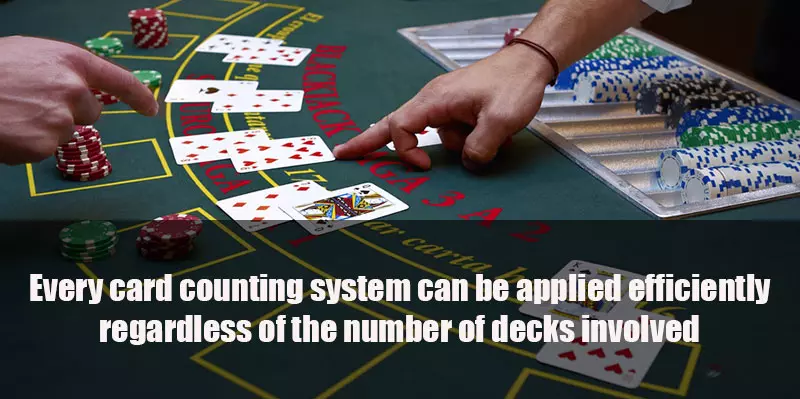
In order to explain how they are calculated in a particular situation, here is a straightforward example. Let’s substitute the ace with a ten-value card and see what the odds will be in this case. The probability that it will be the hole card is 4/13, or 30.77%, and in this situation players’ chances of going bust are 8/13, or 61.54%. If the dealer’s card is five or less, the probability that this will be the hole card is 4/13, or 30.77%, and the chances players can bust are 0%. This is how the game’s odds can be calculated by considering the likelihood of the dealer’s hole card.
The Effect of Card Removal Weakens in Multi-Deck Blackjack
One interesting thing about card removal is that its impact on the odds differs, depending on the number of decks a given blackjack variation uses. The particular set of rules of the game also matters and should be taken into account, of course. But why does deck number impact the EOR?
Some players wrongfully assume the number of decks is irrelevant because the ratio of high to low cards increases proportionately to the number of decks one introduces into the game. While this is true, the more cards are introduced into play, the less pronounced their absence from the deck becomes.
It is one thing to discard one of four aces from a single deck; it’s another thing to remove it from an eight-deck shoe where there are 31 more aces left. The effect on the expected value for the player is not as dramatic.
How Deck Number Changes Blackjack Probabilities
With that in mind, more decks translate into a higher advantage for the house, which, in turn, leads to a lower expectation for basic-strategy players. This is because the instances where players hit blackjacks, split or double down successfully also get diluted by the greater number of cards in play. This sounds counter-intuitive to many people, but the probabilities speak clearly enough.
Here is how this works. The probability of obtaining a blackjack from a freshly shuffled deck is equal to the probability of drawing an ace multiplied by that of pulling out a ten-value card. If you remember, this is what the law of multiplication dictates for dependent events. The result is then multiplied by two to account for the possible permutations, i.e. the specific order in which the cards leave the deck (ace-ten and ten-ace in this instance).
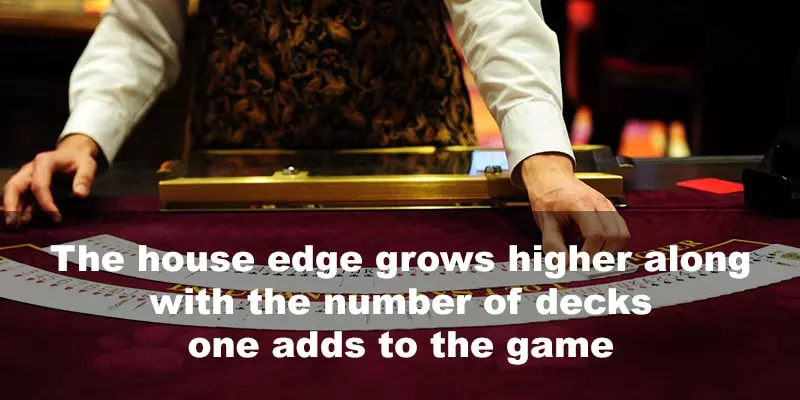
Note that the overall number of cards for the ten’s probability decreases to 51 since one card has been dealt. It follows that the likelihood of a person pulling out an ace and a ten from one full deck is (4 / 52) × (16 / 51) × 2 = 0.0483.
If you perform these calculations for eight decks, you will arrive at the following result: (32 / 416) × (128 / 415) × 2 = 0.0474. This makes for a difference of 0.0009, which seems minuscule, but it can still grind you down in the long run.
The same tendencies are observed for successful double downs, with the probabilities again decreasing along with the introduction of more decks. Interestingly enough, the opposite applies when it comes to being dealt 20 with two ten-value cards. These strong hands tend to occur less frequently the fewer decks are in play. However, this is nothing to cry about since it affects the player and the house equally.
Calculating Expected Value of Blackjack Games
All casino games are designed to favour the house, yielding different percentages in terms of casino advantage. The same applies to blackjack, which has one of the lowest house edges (around 0.50%) with basic strategy.
It is possible for players to overcome this edge and play at an advantage on the condition they learn to count cards. This approach to the game is profitable in the long term as it enables you to gain more information about the composition of the remaining deck or shoe. This information is obtained by keeping track of the discards. Casino Guardian shall cover this topic in more depth later on in this guide.
The above-mentioned house edge is closely related to the expected value of players’ bets. The term refers to the amount players will lose or win in the long term. The vast majority of casino games have a negative expected value since they favour the house. This is not the case for card counters, who get to enjoy a positive expected value over time when the advantage swings in their favour.
Basic-strategy players inevitably face a negative expectation. They can calculate how much playing consistently will cost them over the long haul by multiplying their chosen blackjack game’s house edge by their average wager and the average number of hands they play per hour.
Assuming that one plays a six-deck game with a peeking dealer who hits soft 17, no surrender, doubling on any two cards and doubling after a split, they will face a house edge of 0.006 (0.66%) with basic strategy.
Let’s suppose the person is a flat bettor and wagers $20 per hand on average. One such player would generate roughly sixty hands per hour if joining full tables consistently. Consequently, the expectation they would produce for the house would be 0.006 × $20 × 60, or -$7.20 per hour.
Of course, our hypothetical player will not lose precisely this amount during a single hour of betting. In the short term, they will sometimes win or lose more. In the long run, however, they are likely to arrive at those average hourly losses.
How to Keep the Odds Favourable
Many professional players know that, in order to have an overall positive outcome, they need to concentrate on winning in the long term. This means that whether they made the right decision on one isolated hand is not of great importance. What is really crucial for them is to make sure they do their best and make their choices according to their chosen strategy every time.
Imagine a single drop of wine is put in a cup filled with water. Whoever drinks from it won’t be able to taste anything apart from the water. In the same sense, one incorrect move doesn’t doom players to a certain loss. However, a sequence of particular actions does. In order to make a profit, they need to use the right strategy and stick to it throughout the game, as this is the only way to keep the odds in their favour. Many players lose faith and get discouraged when they make a few incorrect moves and this is one of the most common mistakes.

Conclusion
Every game’s odds can be predicted to some extent, which gives players correspondingly better or worse chances of winning. In blackjack, they have the opportunity to gain an advantage over the casino and achieve the desired goal. It is possible to win with the right strategy and knowledge, but to do so players need to master every aspect of the game. The odds and probabilities help them understand the concepts behind the game and enable them to make better decisions when they are at the table.
The only way to anticipate the results of their actions is to be aware of the possible outcomes. Many players don’t look at the odds of the games, as they believe that all it takes to win is luck. This is simply not true, firstly because the fact that blackjack is a game of skill indicates that it does matter whether players have a strategy and knowledge, and secondly because this excuse allows them to lay the blame elsewhere.
No matter what kind of specialised literature and books about blackjack players might read, it is highly unlikely that they will find a chapter dedicated to being lucky. The reason behind this is simple – there are more important things than luck, such as strategy, knowledge, money-management skills, discipline and attitude. Prior to entering the game, it is an important part of the players’ preparation to become familiar with the possibilities and odds of blackjack in order to know which moves place them in an advantageous position and which are to be avoided.



